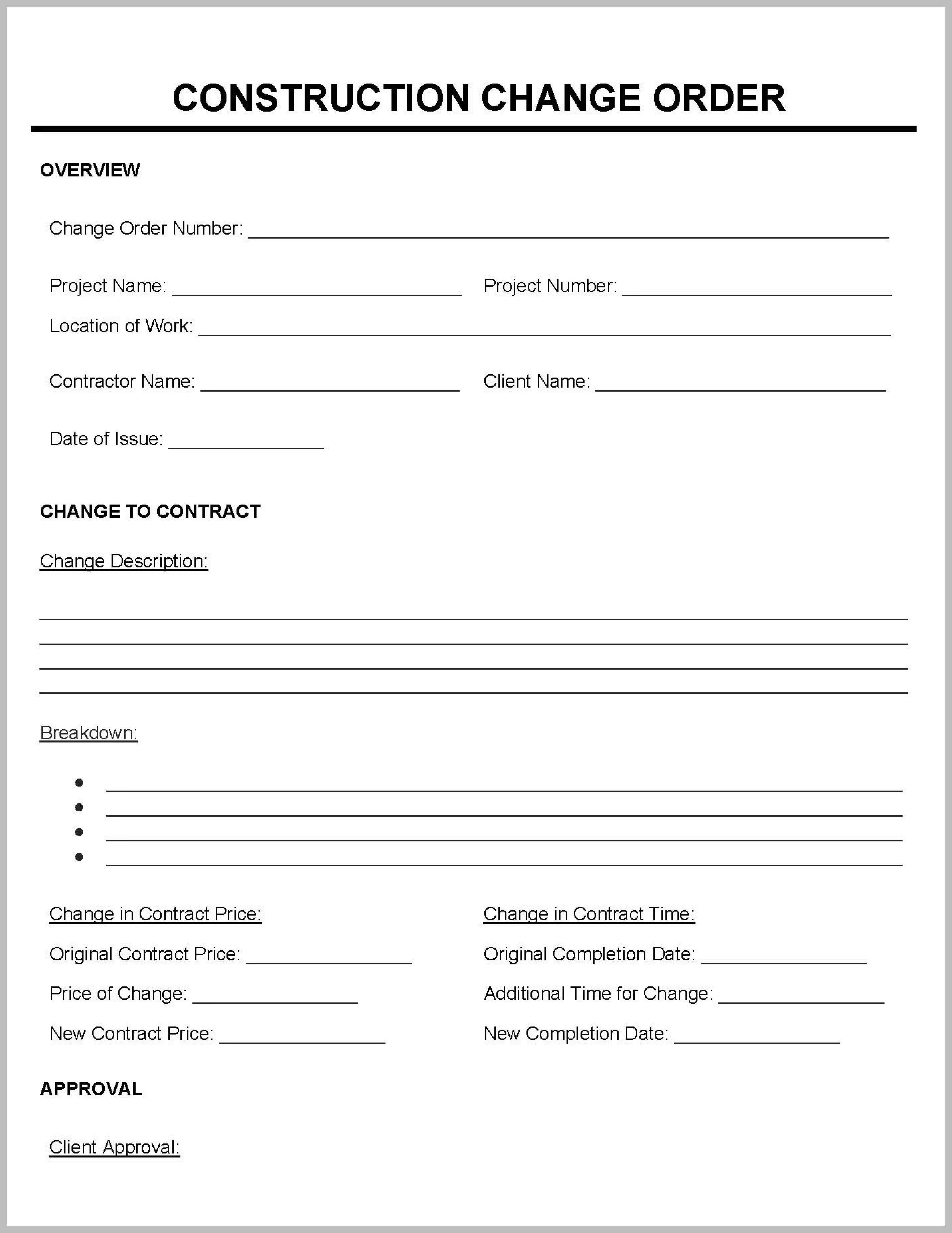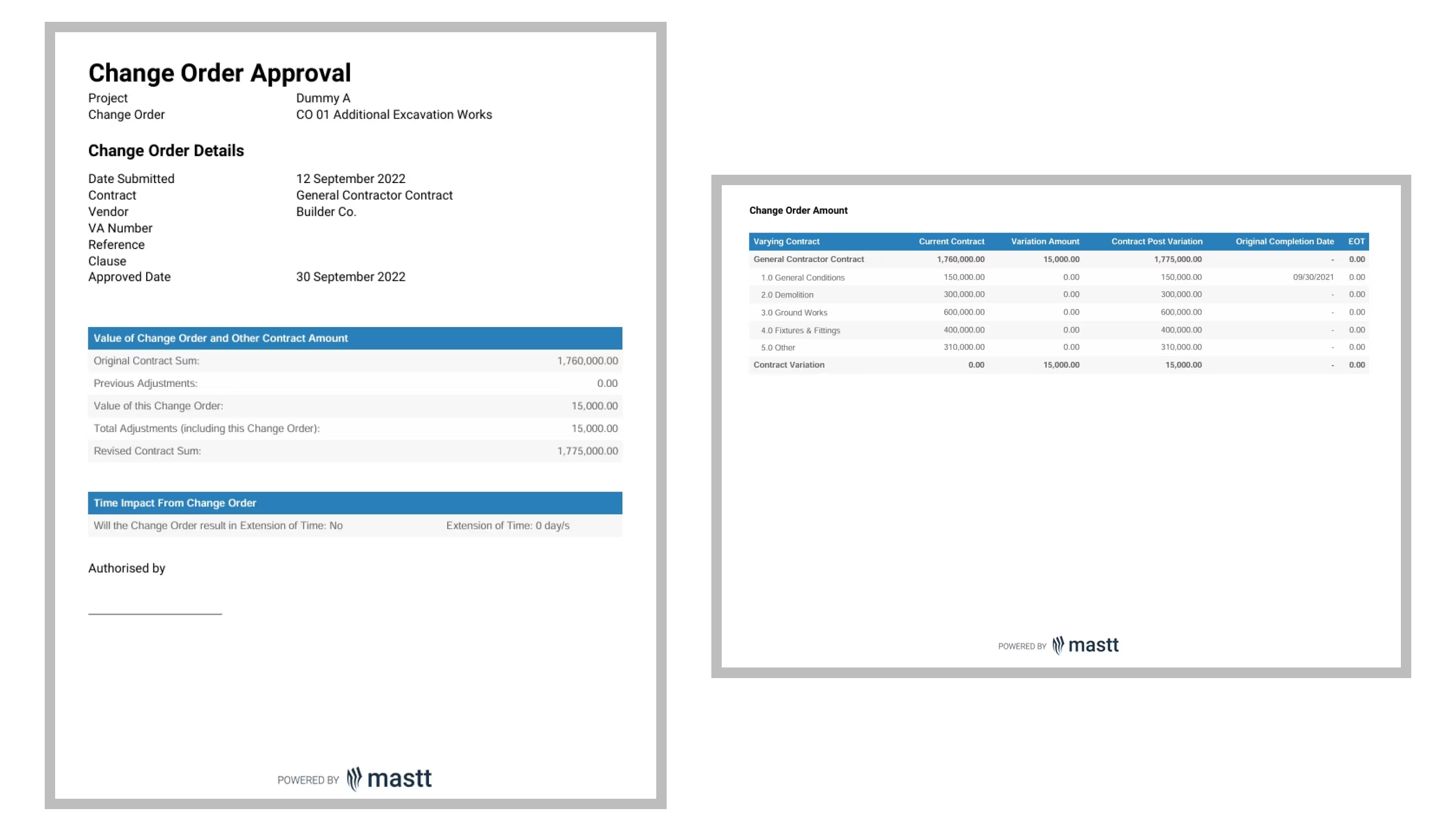Sometimes new ideas, unexpected site issues, or updated rules mean that work does not go exactly as planned. When these changes happen, a construction change order helps everyone know what to do next.
In this guide, we will explain what change orders in construction are, why they happen, who is involved, and how to handle them step by step. We will also show you how digital tools like Mastt make this process easier.
What is a Construction Change Order?
A construction change order is a legal document that changes the original contract. It tells everyone involved what new work is needed, how much extra money or savings are involved, and how the project timeline is affected. This document makes sure that any changes to the project are written down, approved, and followed.
Essentially, a construction change order is used when the project owner, contractor, or architect sees a change that was not planned from the start. These changes may add work, materials, or money (additive changes), or they may remove some work or costs (deductive changes).
For the construction change order to be valid, it must clearly describe the change, list its cost and time impacts, and include the signatures of everyone involved. This formal process helps avoid confusion and disputes later on.

Why Do Change Orders in Construction Happen?
A construction change order happens when the work, budget, or timeline must be adjusted because things do not go as planned. Many factors can trigger these changes, and understanding them can help you manage the project better.
Here are the common reasons for contract modifications in construction:
- Unforeseen Site Conditions: Sometimes, unexpected issues such as unusual soil conditions, hidden underground utilities, or hazardous materials are discovered on site. These surprises force the team to adjust the original plan.
- Design Errors or Omissions: Mistakes in blueprints or missing details can cause confusion. When the design is not perfect, revisions become necessary.
- Regulatory or Code Compliance Changes: New building codes or safety regulations might be introduced after the contract is signed. These rules require changes to meet legal requirements.
- Material or Labor Shortages: Problems in the supply chain or not enough skilled workers can delay work. This situation may force a change in the planned schedule or construction cost estimates.
- Owner-Initiated Changes: If the project owner decides to change the layout, upgrade materials, or add extra features. These changes are often made during the project and need to be documented.
- Safety Concerns: When unexpected hazards or safety risks appear on the site, immediate changes are needed to protect workers and comply with regulations.
- Weather Delays: Severe weather like heavy rain, snow, or extreme heat can slow down work. Adjustments in the timeline are required when weather impacts progress.
For more strategies on managing project budgets and keeping costs in check, read our comprehensive Project Cost Management Guide.
Who is Responsible for a Construction Change Order?
A change order in construction involves several people, each with a specific role to ensure the change is fair and clear. Every stakeholder must work together to confirm that the change is written down and agreed upon.
- Project Owner: The owner approves or requests changes and agrees to any additional costs or time needed.
- General Contractor: The contractor identifies when a change is necessary, prepares the change order, and makes sure the work fits the new plan.
- Architect or Engineer: These professionals review the technical aspects, update design drawings, and ensure that the change meets all safety and quality standards.
- Construction Manager: The manager oversees the entire process, making sure that every step is properly documented and that the project runs smoothly.
- Subcontractors and Suppliers: They adjust their work schedules, orders, and budgets based on the approved change order.
When Should a Change Order in Construction Be Issued?
A change order in construction must be issued as soon as a change is needed. Prompt action is vital to avoid project delays and cost overruns. The sooner everyone agrees on the change, the smoother the project will continue.
Here are the key moments when a change order in construction is necessary:
- Before Construction Starts: During planning, if design errors, scope gaps, or regulatory changes are discovered, a change order should be prepared.
- During Construction: When work is underway and unexpected site conditions, material shortages, or owner requests come up, issuing a change order immediately is essential.
- Post-Construction Adjustments: In the final stages, if inspections or punch lists reveal extra work is needed, a change order is issued to ensure that the project is completed as required.
Issuing the change order promptly ensures that everyone is on the same page and that the project continues without confusion or legal risks.
Where Do Change Orders Apply in a Construction Contract?
Change orders are part of the construction contract. They follow specific rules set out in the contract that explain how changes should be managed.
Here are the key contract sections governing change orders in construction:
- Scope of Work Clause: This section lists the work planned in the original contract and explains what types of changes require a formal change order.
- Change Order Procedure Clause: This part of the contract describes the steps to be taken when a change is needed, such as giving written notice and getting cost estimates and approvals.
- Payment Terms and Adjustments: This clause explains how any extra costs or savings from a change order will affect the overall project budget.
- Dispute Resolution Clause: In case of disagreements over a change, this section outlines the process for resolving them, whether by mediation, arbitration, or other means.
How to Write a Change Order in Construction (Key Elements & Format)
A well-written change order in construction is clear, detailed, and easy to understand. It must include all the the specific modifications, ensure approval from all necessary parties, and document the financial and scheduling impacts.
Every construction change order document should include the following:
1. Project and Contract Information
- Project Name and Location: The name of the project and where it is built.
- Contract Number: The number that links to the original contract.
- Change Order Number: A unique number to keep track of each change.
- Contact Details: The names, phone numbers, and email addresses of the project owner, contractor, and architect/engineer.
2. Description of the Change
- Explanation: A clear, simple description of what is changing.
- Reason: The reason why this change is needed, such as unexpected site issues or an owner request.
- Supporting Documents: Extra papers, updated drawings, or photos that help explain the change.
3. Cost Adjustments
- Breakdown of Costs: A list of the extra costs or savings, including labor, materials, equipment, taxes, and any other related expenses.
- Total Impact: The overall amount added or deducted from the original contract.
4. Schedule Impact
- Time Adjustments: How many more days are needed or saved.
- New Completion Date: If the project finish date changes.
- Justification: A short reason explaining why the schedule needs to be adjusted.
5. Approval and Signatures
- Signatures: The document must be signed by the project owner, contractor, and architect/engineer.
- Date of Approval: The date when the change order was approved, which shows when the new plan starts.
A change order in construction should follow a structured format to ensure clarity and compliance:
💡 Pro Tip: Use a standardized change order template to improve efficiency and ensure all necessary details are included before submission.
The Step-by-Step Construction Change Order Process
Managing a construction change order step by step helps ensure that nothing is missed. Here is a clear, step-by-step process to follow:
Step 1: Identify the Need for a Change Order
Begin by determining if the work, cost, or timeline needs to change. Look for evidence like photos, revised design plans, or written questions (RFIs). This step confirms that a change order is necessary.
Step 2: Draft the Change Order Request
Next, write the change order request. Explain clearly what is changing and why. Include a detailed estimate of the extra cost and a new timeline if needed. Use a standard form to keep the request clear and consistent.
Step 3: Submit for Approval
Send the change order request to the project owner, architect, or other decision-makers. Allow time for discussion and negotiation if needed.
Also, make sure that all required parties review and sign the document. This step prevents disputes and ensures that everyone agrees on the change.
Step 4: Implement the Approved Change
Once the construction change order is approved, notify all team members, subcontractors, and suppliers about the change. Update the schedule and project budget to reflect the new plan. Keep a copy of the approved change order for future reference.
Step 5: Track and Close the Change Order
Finally, add the construction change order to a log or tracking system. Monitor its progress and ensure the new work is completed as specified.
When everything is finished, close the change order and update the final payment records. This step ensures that every change is properly completed and documented.
Common Mistakes to Avoid in Change Order Management in Construction
Many construction projects face problems because of simple mistakes in handling change orders. Knowing these common errors can help you avoid them and keep your project on track.
- Failing to Get the Change Order in Writing: Verbal agreements are not enforceable. Work done without a written and approved change order risks non-payment and contract disputes.
- Submitting Incomplete Documentation: A vague or poorly written construction change order without clear cost breakdowns, scope descriptions, or supporting evidence leads to rejection and delays.
- Delaying the Submission and Approval Process: Waiting too long to issue a change order can disrupt the project schedule and create financial uncertainty. Timely submission ensures that modifications are properly accounted for.
- Ignoring Contract Requirements: Some contracts have strict rules for notifying owners and obtaining approvals within a set timeframe. Missing deadlines can result in rejected change orders or unpaid work.
- Underestimating the Cost and Schedule Impact: Failing to conduct a thorough cost analysis and schedule assessment leads to unexpected budget overruns and timeline extensions. Every change order must have a detailed financial impact evaluation.
- Proceeding with Work Before Approval: Starting work before receiving official approval and signatures puts the contractor at risk. If the owner disputes the change later, payment may be withheld.
- Poor Record-Keeping: Lack of organized documentation makes it difficult to track changes, justify additional costs, and defend claims in disputes. A centralized change order log prevents miscommunication.
Construction Change Orders Best Practices
To effectively manage change orders in construction, you must follow good habits and a clear process. These best practices ensure that changes are handled with minimal disruption and maximum efficiency.
- Standardize the Process: Always use the same steps and change order form for every change order. This makes it easier for everyone to know what to do.
- Communicate Early and Often: Keep all team members, owners, and subcontractors informed about potential changes. Early communication prevents surprises later.
- Document Everything: Write down every change with clear details on cost and time impacts. A digital log or paper records ensure nothing is missed.
- Follow Contract Rules: Stick to the deadlines and procedures laid out in the contract. This helps avoid disputes and legal problems.
- Use Technology: Cloud-based project management tools, like Mastt, can help track and approve changes quickly. These tools make the process smoother and faster.
- Analyze Costs and Time Thoroughly: Check all numbers carefully before sending the change order. Make sure the extra cost and time needed are clear.
- Secure All Approvals Before Proceeding: Do not start any new work until everyone has signed the change order. This protects everyone from later disputes.
- Monitor and Close Out Orders Properly: Keep track of every change until the work is finished and all costs are updated. A final check helps ensure that nothing is left out.

How Mastt Can Help Manage Change Orders in Construction
Mastt is a cloud-based construction project management tool designed to simplify the change order process. It brings all the necessary steps into one easy-to-use system.
Here are some ways Mastt supports construction change order management:
- Centralized Change Order Tracking: Mastt stores all change order requests, approvals, and supporting documents in one secure location. This means nothing gets lost, and everyone can find the latest version quickly.
- Faster Approval Workflow: The tool automates the approval process so that change orders are reviewed and signed off faster. Digital signatures and real-time notifications speed up the process.
- Real-Time Cost Adjustments: When a change order is approved, Mastt updates the budget immediately. This helps project owners and managers see how the changes affect overall costs right away.
- Integrated Document Management: All documents related to the change order, such as updated drawings, photos, and RFIs, are stored together. This integration makes it easier to follow the process and ensures compliance.
- Project Schedule Impact Analysis: Mastt shows how each change order affects the project timeline. Project managers can see if additional days are needed or if the schedule will be shortened, allowing them to adjust plans accordingly.
By using Mastt, construction teams can work more efficiently, reduce mistakes, and keep the project running smoothly. The tool makes it easier to manage change orders, ensuring all stakeholders stay informed and aligned.
Conclusion
Handling changes in construction does not have to be hard. A clear construction change order process helps everyone understand what is happening and keeps the project on track.
By knowing what a change order in construction is, why it happens, who is involved, and how to write and manage one, you can make sure your project runs smoothly.
Always use best practices and software like Mastt to simplify the process. With these steps, even unexpected changes become easy to manage and help lead your project to success.
















.avif)